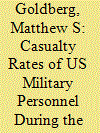| Srl | Item |
| 1 |
ID:
171019


|
|
|
|
|
| Summary/Abstract |
During the past decade, China’s defence industry has experienced significant reforms, with increasing numbers of defence companies being listed on the stock market. Meanwhile, China’s stock market has suffered from dramatic fluctuations. This article, therefore, attempts to break new ground on an empirical research agenda to detect bubbles in the defence sector of China’s stock market and how these bubbles can be impacted by the entire stock market and defence industry. To explain this issue, sequential unit root tests are introduced to investigate the existence of bubbles in the defence sector using monthly frequency data from China’s stock market from January 2005 to June 2016. The empirical results show strong evidence of explosive behaviours in the defence sector during the past decade. Moreover, the number of bubbles has changed greatly when accounting for the entire stock market. The empirical results indicate that bubbles in the middle of 2006 and at the end of 2014 were driven by the defence industry because of the sharp increase of military expenditure and the release of innovative defence reforms. Finally, we suggest that the government could control the annual budget increase at a steady pace and implement defence reforms by carrying out experimental units gradually.
|
|
|
|
|
|
|
|
|
|
|
|
|
|
|
|
| 2 |
ID:
160093


|
|
|
|
|
| Summary/Abstract |
In Operation Iraqi Freedom, which ended in August 2010, nearly 3500 hostile deaths occurred among US military personnel and 32,000 more were wounded in action (WIA). More than 1800 hostile deaths occurred during Operation Enduring Freedom (in and around Afghanistan) through 2014 and about 20,000 were WIA. A larger proportion of wounded personnel survived in Iraq and Afghanistan than during the Vietnam War, but the increased survival rates were not as high as some studies have asserted. The survival rates were 90.2% in Iraq and 91.6% in Afghanistan, compared with 86.5% in Vietnam. The casualty rates varied between the conflicts in Iraq and Afghanistan and before, during, and after the respective surges. Amputation rates are difficult to measure consistently, but I estimate that 2.6% of all WIA and 9.0% of medically evacuated WIA from the Iraq and Afghanistan theaters combined resulted in the major loss of a limb. Elevated non-hostile death rates (including deaths due to accidents, illnesses, homicides, or suicides) resulted in about 220 more deaths in Iraq and about 200 more deaths in Afghanistan than would have been expected in peacetime among populations of the size deployed to those two conflicts.
|
|
|
|
|
|
|
|
|
|
|
|
|
|
|
|
| 3 |
ID:
143604


|
|
|
|
|
| Summary/Abstract |
Increases in military spending have a big impact on the socioeconomic conditions in any country. However, there is no consensus as to whether the rising military expenditure is beneficial or detrimental to economic growth. The present study chose China as a case study to empirically examine a complex relationship between military expenditure and economic development. The findings from the Johansen cointegration test indicated that there existed a long-run relationship between China’s military spending and economic growth. Furthermore, the Granger causality test detected a unidirectional causality from economic development to military expenditure. These results were further confirmed by the findings from the impulse response function. This means that China represents an example of a developing economy where the size of military expenditure expands in the process of economic transformation.
|
|
|
|
|
|
|
|
|
|
|
|
|
|
|
|